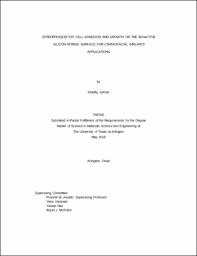
ATTENTION: The works hosted here are being migrated to a new repository that will consolidate resources, improve discoverability, and better show UTA's research impact on the global community. We will update authors as the migration progresses. Please see MavMatrix for more information.
Show simple item record
| dc.contributor.advisor | Aswath, Pranesh B. | |
| dc.contributor.advisor | Varanasi, Venu | |
| dc.creator | Awad, Kamal | |
| dc.date.accessioned | 2020-06-23T18:08:27Z | |
| dc.date.available | 2020-06-23T18:08:27Z | |
| dc.date.created | 2018-05 | |
| dc.date.issued | 2018-04-27 | |
| dc.date.submitted | May 2018 | |
| dc.identifier.uri | http://hdl.handle.net/10106/29154 | |
| dc.description.abstract | As a novel biomaterial, silicon nitride (Si3N4) has been used for orthopedic and spinal fusion applications. Its ability to promote continuity for structural support of missing bone, by in/on bone growth, gives it advantageous properties and potential for mandibular and craniofacial reconstruction applications. Yet, the surface properties of this material and its effect on the osteogenic properties have not been fully realized. Thus, the aim of this study was to evidently investigate the surface properties of the bioactive Si3N4 that enhance the calvarial osteoblasts cell adhesion, growth, and differentiation when compared to conventional implant materials such as titanium (Ti) and polyetheretherketone (PEEK). This study tests the hypothesis that silicon nitride induces the nucleation of hydrox-yapatite (HA) crystals and enhances the formation of biominerals on its surfaces in cell-free environments and in presence of osteoprogenitor cells as well. Comprehensive studies of the bare surface properties, HA and biomineral formations, and cell culture studies of osteoprogenitor cells were conducted. We present the results of surface properties that enhance the formation of biomineral and osteoprogenitor responses as compared to traditionally used Ti and PEEK. X-ray Absorbance Near Edge Structure Analysis (XANES) indicated the presence of Si-Si, Si-O, and Si-N bonding, which suggested random mixing of these bonding structures. Atomic Force Microscopy (AFM), and optical and stylus profilometry successfully assessed the morphological features and the roughness parameters of the surfaces. The Sessile drop technique was used to study the surfaces’ wettability, and the resultant contact angles were used to calculate the surface energy of each material. FT-IR and Raman spectroscopy were used to characterize mineral formations on the sur-face of all samples before and after in vitro studies. Each material was imaged for its respective surface morphology using an Ultra HR-SEM, and the elemental composition was determined by the energy-dispersive x-ray spectroscopy (EDS). X-ray diffraction was used to investigate the HA formation on sample surfaces after 7 days of immersion in α-MEM. Meanwhile, murine calvarial MC3T3-E1 osteoblast in vitro cell studies and quantitative polymerase chain reaction will illustrate the enhancing nature of silicon nitride to promote osteogenesis. Furthermore, comprehensive study of the extracellular matrix (ECM) deposition was conducted after 30 and 60 days of the MC3T3-E1 osteoblast in vitro cell culture. Our study concludes and illustrates the ability of silicon nitride to promote rapid hydroxyapatite formation in cell-free environments and induce rapid osteoblast adhesion, growth, and dense ECM deposition compared to the conventional implant materials (Ti) and (PEEK). | |
| dc.format.mimetype | application/pdf | |
| dc.language.iso | en_US | |
| dc.subject | Silicon nitride | |
| dc.subject | craniofacial implants | |
| dc.subject | hydroxyapatite nucleation | |
| dc.subject | hydroxyproline | |
| dc.subject | amide surface formation | |
| dc.subject | matrix deposition. | |
| dc.title | OSTEOPROGENITOR CELL ADHESION AND GROWTH ON THE BIOACTIVE SILICON NITRIDE SURFACE FOR CRANIOFACIAL IMPLANTS APPLICATIONS | |
| dc.type | Thesis | |
| dc.degree.department | Materials Science and Engineering | |
| dc.degree.name | Master of Science in Materials Science and Engineering | |
| dc.date.updated | 2020-06-23T18:08:28Z | |
| thesis.degree.department | Materials Science and Engineering | |
| thesis.degree.grantor | The University of Texas at Arlington | |
| thesis.degree.level | Masters | |
| thesis.degree.name | Master of Science in Materials Science and Engineering | |
| dc.type.material | text | |
| dc.creator.orcid | 0000-0003-3621-1136 | |
Files in this item
- Name:
- AWAD-THESIS-2018.pdf
- Size:
- 5.402Mb
- Format:
- PDF
This item appears in the following Collection(s)
Show simple item record


